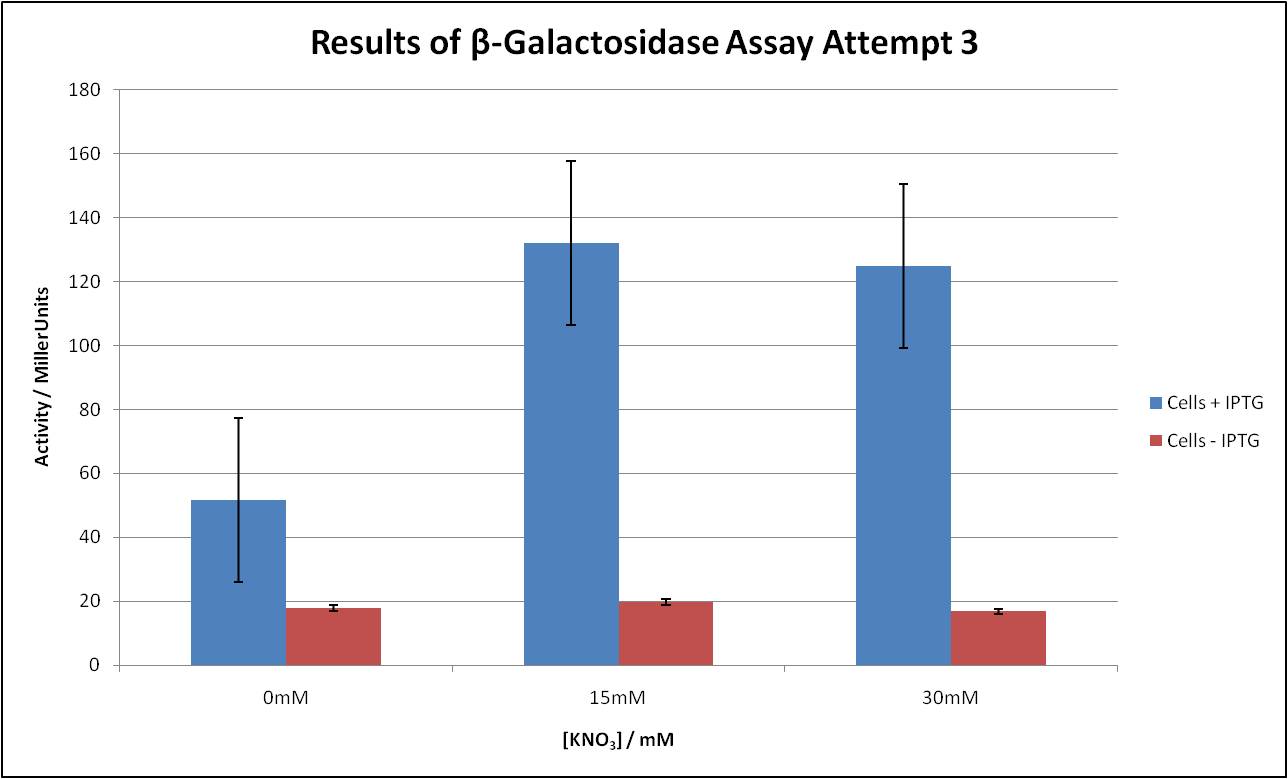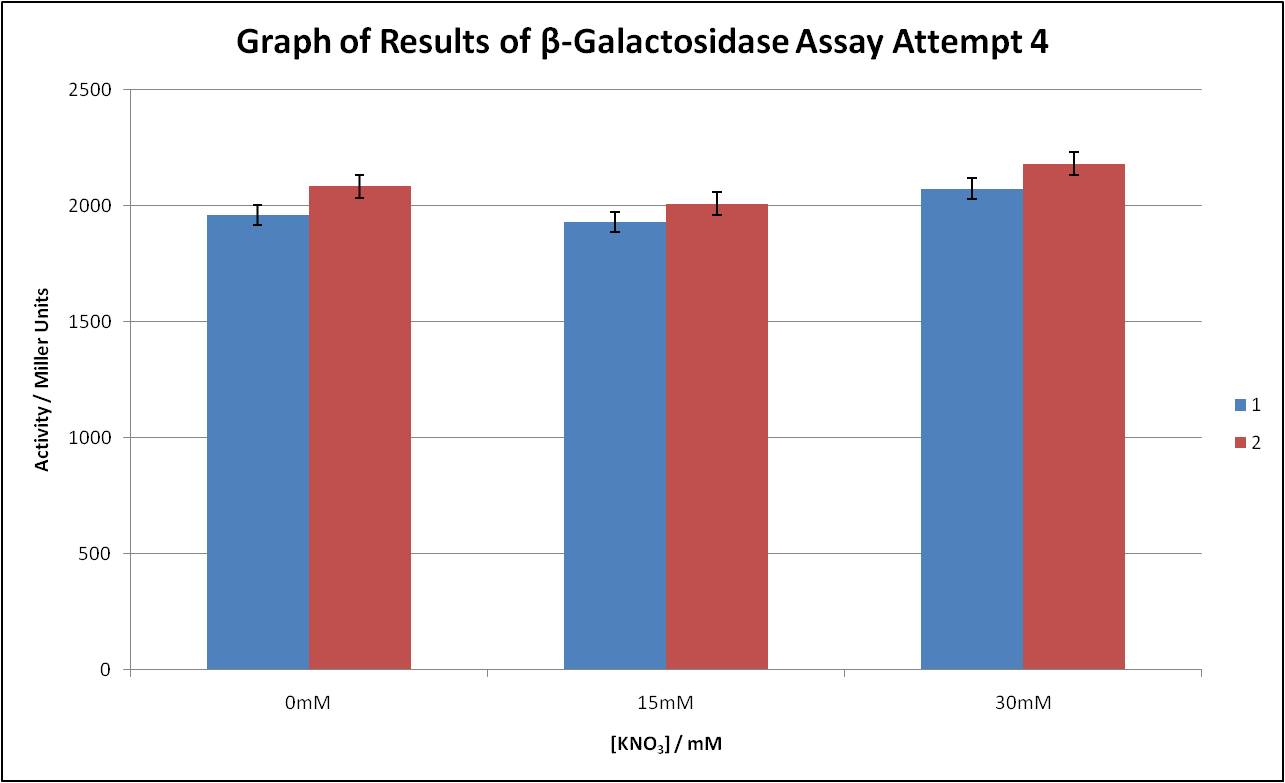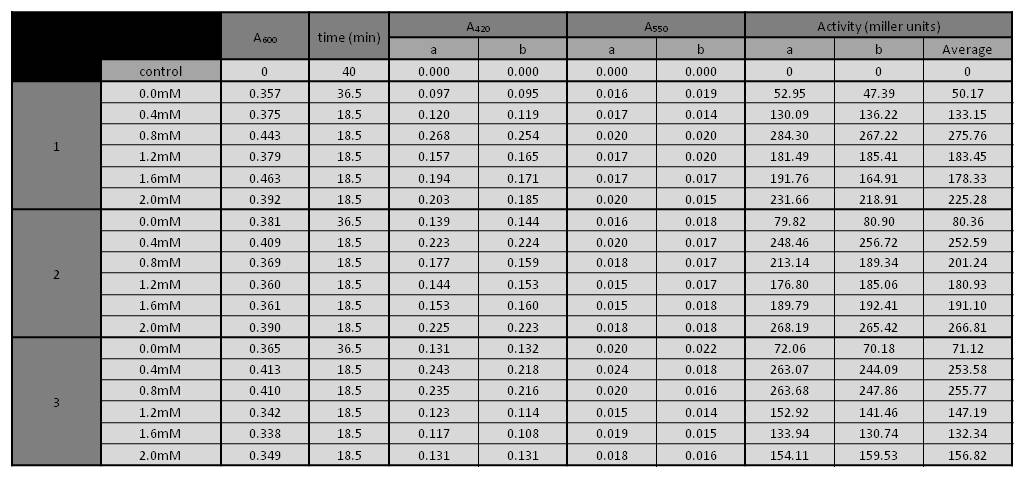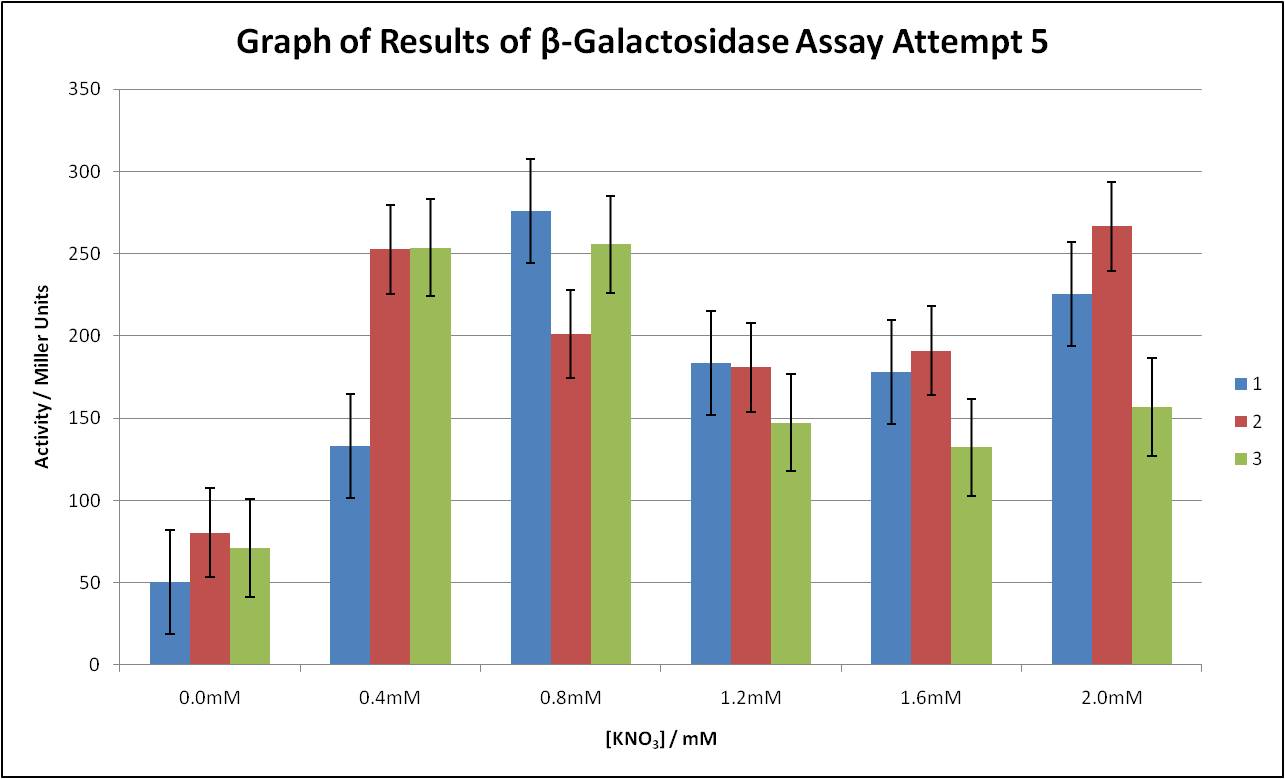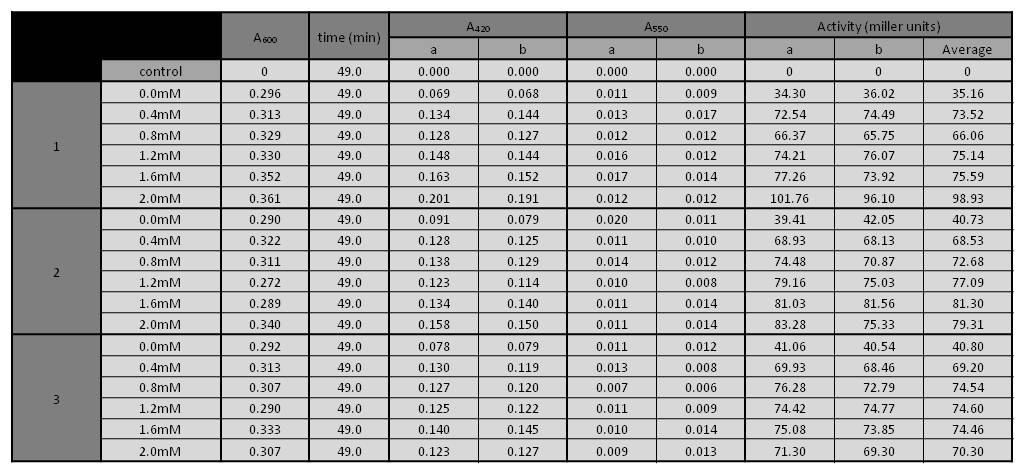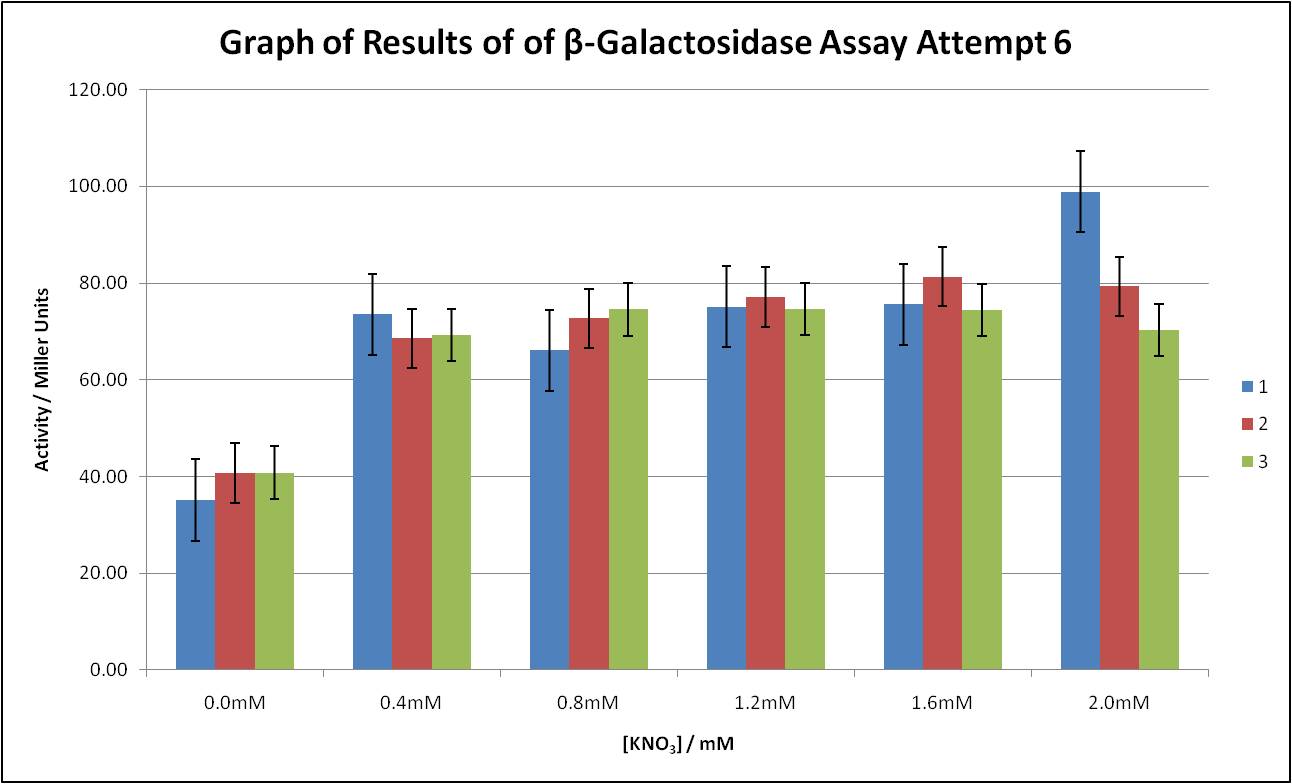Team:BCCS-Bristol/Wetlab/BetaGalactosidaseAssays
From 2010.igem.org
iGEM 2010
β-Galactosidase Assays
Contents |
Motivation
In order to properly map the PyeaR part in the range of soil nitrate concentrations that agrEcoli would be exposed to, we needed to get some data on the sensitivity of the component within that small range of concentrations. To that end, we decided that a β-galactosidase assay would be the most appropriate method of obtaining that data, especially given that Edinburgh were kind enough to provide us with the necessary BioBrick to run the tests.
Unfortunately it turned out that the [http://partsregistry.org/Part:BBa_K216009 BBa_K216009] part was not entirely appropriate for the assay - the data could be limited by the cellular expression of the LacZΩ portion of β-galactosidase which is under the regulation of a separate promoter on the chromosomal DNA. So we decided to build our own biobrick to enable us to run the tests (see the page on design of the PyeaR+LacZ construct for more details). However this wasn't a success and so we returned to [http://partsregistry.org/Part:BBa_K216009 BBa_K216009] in order to get data on the PyeaR part.
The assay
The general procedure for the assay, whether using the [http://partsregistry.org/Part:BBa_K216009 BBa_K216009] part or our own BioBrick (we made one attempt to use our own construct before realising that the ligation had failed).
Day one
Prepare overnight cultures of E.coli containing the relevant BioBrick - one culture per repeat of the experiment.
Prepare the following solutions for use during the assay:
Z Buffer - 500mL
- Prepare 1M solutions of the following:
- KCl
- 1x20mL aliquot - 1.49g in 20mL ddH2O
- MgSO4
- 1x20mL aliquot - 2.40g in 20mL ddH2O
- Na2HPO4
- 2x20mL aliquots - 2.84g in 20mL ddH2O
- NaH2PO4
- 1x20mL aliquot - 2.76g in 20mL ddH2O
- KCl
- Combine these as stated in the table below
| Solution | Concentration required | Volume of 1M stock |
| KCl | 0.01M | 5.0mL |
| MgSO4 | 0.001M | 0.5mL |
| Na2HPO4 | 0.06M | 30.0mL |
| NaH2PO4 | 0.03M | 15.0mL |
| β-mercaptoethanol | 0.05M | Add 270μL to ~100mL Z Buffer on day of use |
- This can then be separated into ~100mL aliquots and will keep until required.
1M Na2CO3 - 250mL
- 26.5g Na2CO3 dissolved in 250mL ddH2O
1M KNO3 - 50mL
For our assays we wish to measure the sensitivity of the PyeaR promoter to nitrate levels so we included KNO3 as the test solution - this is not a standard β-galactosidase assay solution!
- 5.05g KNO3 dissolved in 50mL ddH2O.
- This was then autoclaved for sterility.
Day two
- Measure A600 of overnight cultures (diluted to 1/10). Us an appropriate volume to inoculate 5mL of LB + 5μL Ampicillin at an initial A600 of 0.007, plus any other added solutions such as KNO3 and IPTG. Incubate (shaken) at 37°C until A600 is 0.3 - 0.5 (usually approx. 3 hours, depending on strain). Remove (and discard) 1mL aliquots to monitor A600 during growth. It is important that all cultures are harvested at a similar cell density. When the culture reaches the desired cell density place on ice immediately and record the A600.
- At this point it is a good idea to prepare the two remaining solutions of ONPG and SDS (required later in the assay) and to add the β-mercaptoethanol to the Z buffer.
- 0.1% SDS solution made up from 10% stock - need 60μL per culture being assayed
- 4mg/mL solution of ONPG in Z buffer - need 400μL per culture being assayed
- At this point it is a good idea to prepare the two remaining solutions of ONPG and SDS (required later in the assay) and to add the β-mercaptoethanol to the Z buffer.
- From this point on there is no need to worry about aseptic technique! For each culture being assayed set up two small test tubes containing 0.9mL of Z buffer. Also set up a control containing 1mL of Z buffer.
- Mix the culture by gentle vortexing, then transfer 100μL to each of the test tubes containing Z buffer. Add 30μL of 0.1% SDS and 30μL of chloroform and the vortex for exactly 10 seconds to lyse the cells. Place the lysates on ice until all samples are ready to assay. Also add SDS and chloroform to the "no lysate" control.
- Place samples in a 30°C water-bath and allow temperature to equilibrate.
- Start reactions by adding 200μL of 4mg/mL ONPG in Z buffer and vortexing for approx. 5 seconds. Note the time at which each reaction was started and stagger the reactions at 30 second intervals. Also add ONPG to the "no lysate" control.
- When the reaction mixtures have turned pale yellow (or after 60 minutes, whichever is the sooner) stop the reaction by adding 0.5mL of 1M Na2CO3 and vortexing briefly. Note the time at which each reaction was stopped, and record the total incubation time. Also add Na2CO3 to the "no lysate" control.
- Measure and record A420 and A550 of each reaction mixture, using the "no lysate" control to set "zero" at each wavelength.
- Calculate specific β-galactosidase activity (Miller units) according to the equation:
(A420 gives a value for o-nitrophenol concentration; A550 gives a value for cell debris scattering (the procedure of the β-Galactosidase assay requires cells to be broken apart); 0.1 is the volume of cell lysate used in the assay, and; A600 gives the cell density before lysis).
Our results
In total there were 6 runs made of the procedure made, some more successful than others. Attempt 2 was stopped after letting the 30°C incubation run for an extra hour and still not observing colour change. Attempts 4 and 5 both achieved bad data that was not used in the final characterisation of PyeaR by our team. Attempt 6 produced reproducible data but it wasn't quite what we were hoping to show. These are our results for the various repeats of the assay.
Attempt 1
In this example, the first run of the assay we attempted, the full data collected has been shown. For the remainder of the runs, only the data important to the formula above has been included.
- Growth monitoring of the cultures at 37°C
| Culture set and [KNO3] | A600 after 2 hours | A600 after 3 hours | A600 after 3 hours 10 minutes |
| 1. 0mM KNO3 | 0.09 | 0.29 | n/a |
| 1. 20mM KNO3 | 0.08 | 0.27 | n/a |
| 1. 100mM KNO3 | 0.04 | 0.16 | 0.31 |
| 2. 0mM KNO3 | 0.08 | 0.29 | n/a |
| 2. 20mM KNO3 | 0.08 | 0.28 | n/a |
| 2. 100mM KNO3 | 0.05 | 0.18 | 0.33 |
- Reaction time data table
| Culture set and [KNO3] | Time started (A) | Time started (B) | Time stopped (A) | Time stopped (B) | Total incubation time / minutes |
| 1. 0mM KNO3 | 14:40.0 | 14:40.5 | 15:55.0 | 15:55.5 | 75 |
| 1. 20mM KNO3 | 14:43.0 | 14:43.5 | 15:58.0 | 15:58.5 | 75 |
| 1. 100mM KNO3 | 14:45.0 | 14:45.5 | 16:00.0 | 16:00.5 | 75 |
| 2. 0mM KNO3 | 14:42.0 | 14:42.5 | 15:57.0 | 15:57.5 | 75 |
| 2. 20mM KNO3 | 14:44.0 | 14:44.5 | 15:57.0 | 15:57.5 | 75 |
| 2. 100mM KNO3 | 14:46.0 | 14:46.5 | 16:01.0 | 16:01.5 | 75 |
| "no lysate" control | 14:41.0 | 14:41.5 | 15:56.0 | 15:56.5 | 75 |
- A420/A550 data table
| Culture set and [KNO3] | A420 (A) | A420 (B) | A550 (A) | A550 (B) |
| 1. 0mM KNO3 | 0.034 | 0.036 | 0.014 | 0.016 |
| 1. 20mM KNO3 | 0.026 | 0.022 | 0.018 | 0.006 |
| 1. 100mM KNO3 | 0.032 | 0.031 | 0.013 | 0.011 |
| 2. 0mM KNO3 | 0.039 | 0.030 | 0.017 | 0.011 |
| 2. 20mM KNO3 | 0.033 | 0.037 | 0.012 | 0.015 |
| 2. 100mM KNO3 | 0.033 | 0.029 | 0.013 | 0.010 |
- Activities as calculated using the Miller Equation given above
| Culture set and [KNO3] | Activity (A) / Miller Units | Activity (B) / Miller Units |
| "no lysate" control | 0 | 0 |
| 1. 0mM KNO3 | 4.368 | 3.678 |
| 1. 20mM KNO3 | (neg)2.716 | 5.679 |
| 1. 100mM KNO3 | 7.742 | 5.054 |
| 2. 0mM KNO3 | 7.471 | 6.552 |
| 2. 20mM KNO3 | 5.714 | 5.119 |
| 2. 100mM KNO3 | 4.141 | 4.646 |
No graph provided for this experimental data - activity consistently low.
Attempt 2
No data was gathered as no colour change was observed during the incubation period. With this in mind, the identity of the BioBrick was investigated - it was at this stage we realised that the BioBrick only contained LacZα, not the full copy of LacZ we had originally thought. Armed with this new information we transformed the XL1-Blue E.coli strain and tested adding IPTG to the cultures in attempt 3.
Attempt 3
- Cultures were grown at 0mM, 15mM and 30mM [KNO3]. Two parallel sets of cultures were set up, one in the presence of IPTG (set 1), one in the absence of IPTG (set 2). All cultures were grown in both Ampicillin and Tetracyclin together.
- Table
- Graph
With these pleasing results we went on to attempt to create our PyeaR+LacZ(full) construct. Attempt 4 was made with the construct before we discovered the slight faults that had occurred during its preparation.
Attempt 4
- Cultures of M182 cells plus the new construct were grown at 0mM, 15mM and 30mM [KNO3]. All cultures were grown in Ampicillin.
- Table
- Graph
As is clearly shown by the graph, the results are now the complete opposite of our original observations - consistently high activity, with no correlation to the [KNO3]. On sequencing of the construct, the reason behind this is clear. The promoter sequence (PyeaR) doesn't appear in the construct! (see the page on design of the PyeaR+LacZ construct for more details). After this, we returned to the [http://partsregistry.org/Part:BBa_K216009 BBa_K216009] for the final two attempts at getting some worthwhile data.
Attempt 5
- It was clear now that we needed to get some data that we could use, within a useful range of nitrate concentrations applicable to the conditions faced by agriColi whilst on the soil. To this end we decided to start attempting parallel assays in triplicate, across a much more focused range of concentrations.
- Cultures of XL1-Blue cells plus the [http://partsregistry.org/Part:BBa_K216009 BBa_K216009] biobrick were grown in the at 0mM, 0.4mM, 0.8mM, 1.2mM, 1.6mM and 2.0mM [KNO3]. Three separate groups were assayed, and all cultures were grown in the presence of IPTG, Ampicillin and Tetracyclin.
- Table
- Graph
- As you can clearly see the results shown are somewhat erratic and no clear correlation is observed. This is due to a slip during the procedure where the cells were not properly vortexed to cause sufficient cell lysis and subsequent release of the β-galactosidase into the cell lysate. Attempt 6 would be the final β-galactosidase assay attempt.
Attempt 6 (Final)
- The final attempt was set up in exactly the same way as the fifth attempt: Cultures of XL1-Blue cells plus the [http://partsregistry.org/Part:BBa_K216009 BBa_K216009] biobrick were grown in the at 0mM, 0.4mM, 0.8mM, 1.2mM, 1.6mM and 2.0mM [KNO3]. Three separate groups were assayed, and all cultures were grown in the presence of IPTG, Ampicillin and Tetracyclin.
- Table
- Graph
- We finally achieved reproducible data! With this under our belts, we decided to call it a day on the β-galactosidase assay side of the project.
 "
"

